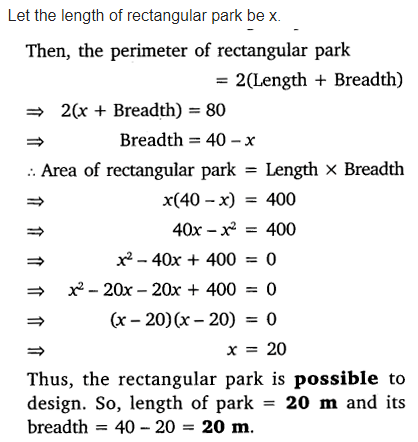NCERT Solutions For Class 10 Maths Chapter 4 Quadratic Equations Exercise 4
NCERT Solutions For Class 10 Maths Chapter 4 Quadratic Equations are prepared by specialised experienced teacher of mathematic. Maths are most important subject of board and with the help of this chapter-wise NCERT solution and little practices you can get very good marks in your respective board exam. It also help to build a foundation for topics that will be covered in the upcoming 11th and 12th.
Class 10 Maths Chapter 4 Quadratic Equations chapter contain total 7 exercise and it covered the topic in-depth explanation, method of solving the quadratic equation through the factorisation method, completing the square method finding the roots of the equation, and splitting the middle term. Check Pre chapter – NCERT solution for class 10 Maths chapter 3 Pair of Linear Equations in Two Variables
Exercise 4.1
Question 1.
Check whether the following are quadratic equations:
(i) (x+ 1)2=2(x-3)
(ii) x – 2x = (- 2) (3-x)
(iii) (x – 2) (x + 1) = (x – 1) (x + 3)
(iv) (x – 3) (2x + 1) = x (x + 5)
(v) (2x – 1) (x – 3) = (x + 5) (x – 1)
(vi) x2 + 3x + 1 = (x – 2)2
(vii) (x + 2)3 = 2x(x2 – 1)
(viii) x3 -4x2 -x + 1 = (x-2)3
Solution:
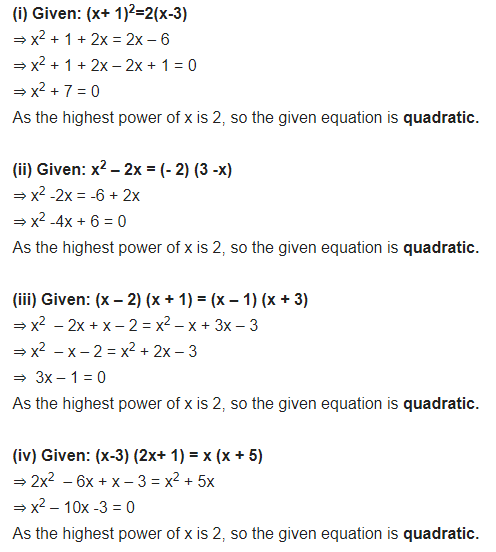
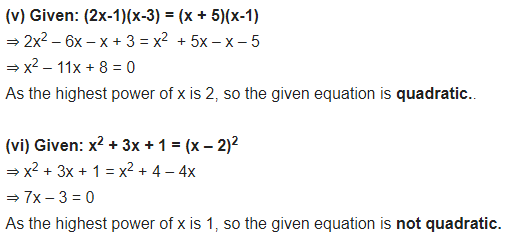
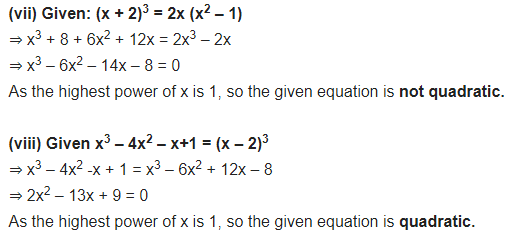
Question 2.
Represent the following situations in the form of quadratic equations:
(i) The area of a rectangular plot is 528 m2. The length of the plot (in metres) is one more than twice its breadth. We need to find the length and breadth of the plot.
(ii) The product of two consecutive positive integers is 306. We need to find the integers.
(iii) Rohan’s mother is 26 years older than him. The product of their ages (in years) 3 years from now will be 360. We would like to find Rohan’s present age.
(iv) A train travels a distance of 480 km at a uniform speed. If the speed had been 8 km/h less, then it would have taken 3 hours more to cover the same distance. We need to find the speed of the train.
Solution:
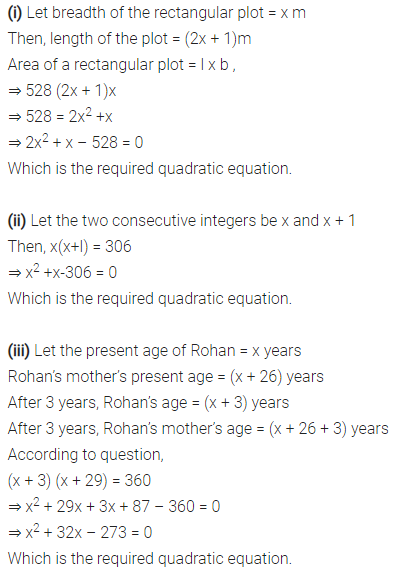
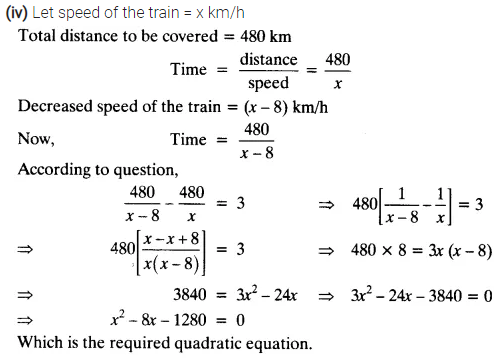
Exercise 4.2
Question 1.
Find the roots of the following quadratic equations by factorisation:
(i) x2 – 3x – 10 = 0
(ii) 2x2 + x – 6 = 0
(iii) √2 x2 + 7x + 5√2 = 0
(iv) 2x2 – x +1/8 = 0
(v) 100x2 – 20x + 1 = 0
Solution:
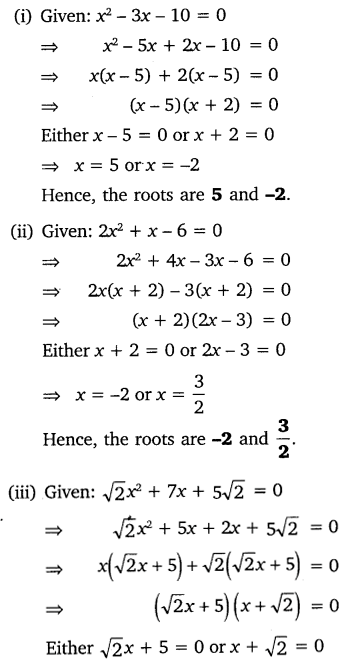
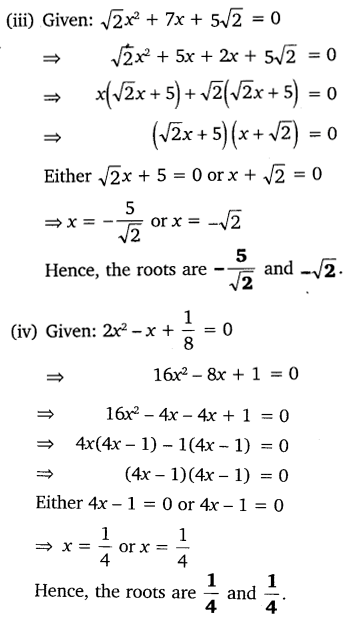
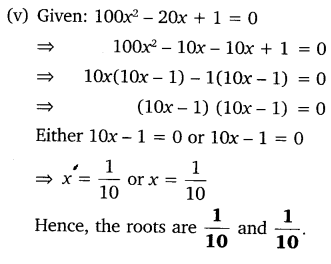
Question 2.
Solve the following situations mathematically:
(i) John and Jivanti together have 45 marbles. Both of them lost 5 marbles each and the product of the number of marbles they now have is 124. We would like to find out how many marbles they had to start with.
(ii) A cottage industry produces a certain number of toys in a day. The cost of production of each toy (in rupees) was found to be 55 minus the number of toys produced in a day. On a particular day, the total cost of production was ₹750. We would like to find out the number of toys produced on that day.
Solution:
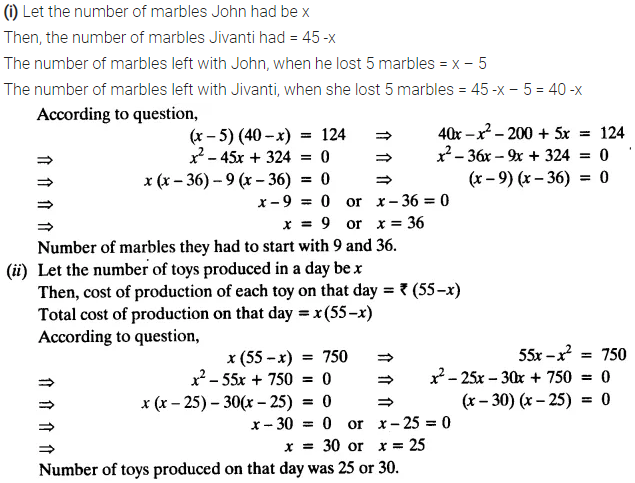
Question 3.
Find two numbers whose sum is 27 and product is 182.
Solution:
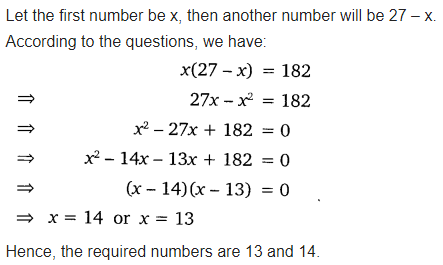
Question 4.
Find two consecutive positive integers, the sum of whose squares is 365.
Let us say, the two consecutive positive integers be x and x + 1.
Therefore, as per the given questions,
x2 + (x + 1)2 = 365
⇒ x2 + x2 + 1 + 2x = 365
⇒ 2x2 + 2x – 364 = 0
⇒ x2 + x – 182 = 0
⇒ x2 + 14x – 13x – 182 = 0
⇒ x(x + 14) -13(x + 14) = 0
⇒ (x + 14)(x – 13) = 0
Thus, either, x + 14 = 0 or x – 13 = 0,
⇒ x = – 14 or x = 13
since, the integers are positive, so x can be 13, only.
∴ x + 1 = 13 + 1 = 14
Therefore, two consecutive positive integers will be 13 and 14.
Question 5.
The altitude of a right triangle is 7 cm less than its base. If the hypotenuse is 13 cm, find the other two sides.
Solution:
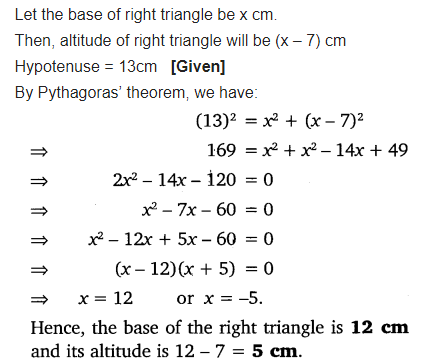
Question 6.
A cottage industry produces a certain number of pottery articles in a day. It was observed on a particular day that the cost of production of each article (in rupees) was 3 more than twice the number of articles produced on that day. If the total cost of production on that day was ₹90, find the number of articles produced and the cost of each article.
Solution:
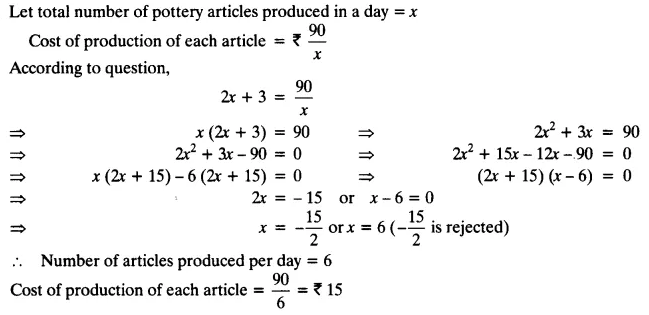
Exercise 4.3
Question 1.
Find the roots of the following quadratic equations, if they exist, by the method of completing the square:
(i) 2x2 – 7x + 3 = 0
(ii) 2x2 + x – 4 = 0
(iii) 4x2 + 4√3x + 3 = 0
(iv) 2x2 + x + 4 = 0
Solutions:
(i) 2x2 – 7x + 3 = 0
⇒ 2x2 – 7x = – 3
Dividing by 2 on both sides, we get
⇒ x2 -7x/2 = -3/2
⇒ x2 -2 × x ×7/4 = -3/2
On adding (7/4)2 to both sides of equation, we get
⇒ (x)2-2×x×7/4 +(7/4)2 = (7/4)2-3/2
⇒ (x-7/4)2 = (49/16) – (3/2)
⇒(x-7/4)2 = 25/16
⇒(x-7/4)2 = ±5/4
⇒ x = 7/4 ± 5/4
⇒ x = 7/4 + 5/4 or x = 7/4 – 5/4
⇒ x = 12/4 or x = 2/4
⇒ x = 3 or x = 1/2
(ii) 2x2 + x – 4 = 0
⇒ 2x2 + x = 4
Dividing both sides of the equation by 2, we get
⇒ x2 +x/2 = 2
Now on adding (1/4)2 to both sides of the equation, we get,
⇒ (x)2 + 2 × x × 1/4 + (1/4)2 = 2 + (1/4)2
⇒ (x + 1/4)2 = 33/16
⇒ x + 1/4 = ± √33/4
⇒ x = ± √33/4 – 1/4
⇒ x = (± √33-1)/4
Therefore, either x = (√33-1)/4 or x = (-√33-1)/4
(iii) 4x2 + 4√3x + 3 = 0
Converting the equation into a2+2ab+b2 form, we get,
⇒ (2x)2 + 2 × 2x × √3 + (√3)2 = 0
⇒ (2x + √3)2 = 0
⇒ (2x + √3) = 0 and (2x + √3) = 0
Therefore, either x = -√3/2 or x = -√3/2.
(iv) 2x2 + x + 4 = 0
⇒ 2x2 + x = -4
Dividing both sides of the equation by 2, we get
⇒ x2 + 1/2x = 2
⇒ x2 + 2 × x × 1/4 = -2
By adding (1/4)2 to both sides of the equation, we get
⇒ (x)2 + 2 × x × 1/4 + (1/4)2 = (1/4)2 – 2
⇒ (x + 1/4)2 = 1/16 – 2
⇒ (x + 1/4)2 = -31/16
As we know, the square of numbers cannot be negative.
Therefore, there is no real root for the given equation, 2x2 + x + 4 = 0.
Question 2.
Find the roots of the quadratic equations by applying the quadratic formula.
(i) 2x2 – 7x + 3 = 0
(ii) 2x2 – x + 4 = 0
(iii) 4x2 – 4√3x + 3 = 0
(iv) 2x2 – x + 4 = 0
Solution:
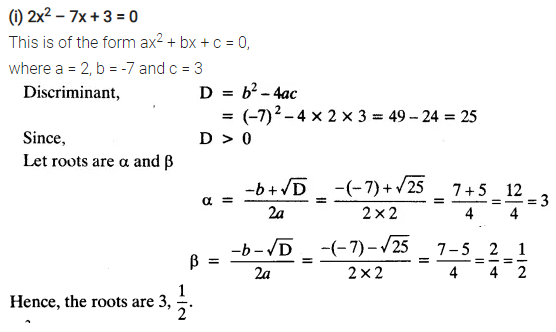
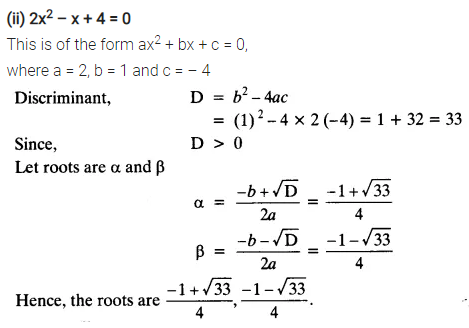
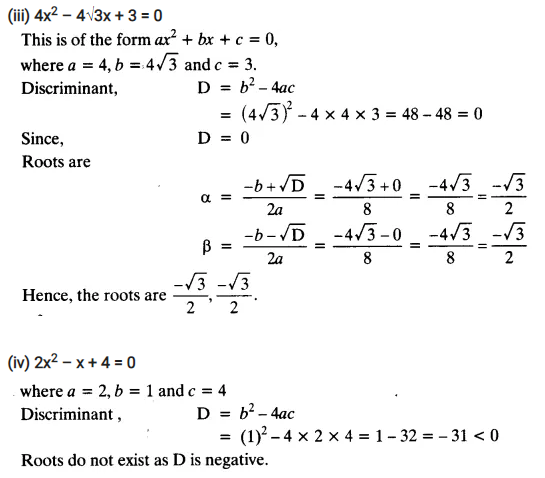
Question 3.
Find the roots of the following equations:
(i) x-1/x = 3, x ≠ 0
(ii) 1/x+4 – 1/x-7 = 11/30, x = -4, 7
Solution:
(i) x-1/x = 3
⇒ x2 – 3x -1 = 0
On comparing the given equation with ax2 + bx + c = 0, we get
a = 1, b = -3 and c = -1
By using quadratic formula, we get,

⇒ x = (3±√9+4)/2
⇒ x = (3±√13)/2
∴ x = (3+√13)/2 or x = (3-√13)/2
(ii) 1/x+4 – 1/x-7 = 11/30
⇒ x-7-x-4/(x+4)(x-7) = 11/30
⇒ -11/(x+4)(x-7) = 11/30
⇒ (x+4)(x-7) = -30
⇒ x2 – 3x – 28 = 30
⇒ x2 – 3x + 2 = 0
We can solve this equation by factorization method now,
⇒ x2 – 2x – x + 2 = 0
⇒ x(x – 2) – 1(x – 2) = 0
⇒ (x – 2)(x – 1) = 0
⇒ x = 1 or 2
Question 4.
The sum of the reciprocals of Rehman’s ages, (in years) 3 years ago and 5 years from now is 13 Find his present age.
Solution:
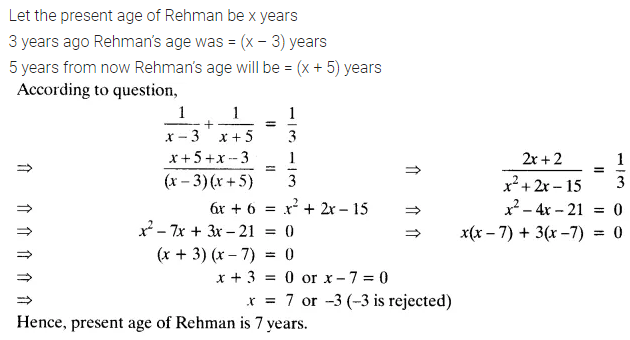
Question 5.
In a class test, the sum of Shefali’s marks in Mathematics and English is 30. Had she got 2 marks more in Mathematics and 3 marks less in English, the product of their marks would have been 210. Find her marks in the two subjects.
Solution:
Let us say, the marks of Shefali in Maths be x.
Then, the marks in English will be 30 – x.
As per the given question,
(x + 2)(30 – x – 3) = 210
(x + 2)(27 – x) = 210
⇒ -x2 + 25x + 54 = 210
⇒ x2 – 25x + 156 = 0
⇒ x2 – 12x – 13x + 156 = 0
⇒ x(x – 12) -13(x – 12) = 0
⇒ (x – 12)(x – 13) = 0
⇒ x = 12, 13
Therefore, if the marks in Maths are 12, then marks in English will be 30 – 12 = 18 and the marks in Maths are 13, then marks in English will be 30 – 13 = 17.
Question 6.
The diagonal of a rectangular field is 60 metres more than the shorter side. If the longer side is 30 metres more than the shorter side, find the sides of the field.
Solution:
Let us say, the shorter side of the rectangle be x m.
Then, larger side of the rectangle = (x + 30) m
![]()
As given, the length of the diagonal is = x + 30 m
Therefore,
![]()
⇒ x2 + (x + 30)2 = (x + 60)2
⇒ x2 + x2 + 900 + 60x = x2 + 3600 + 120x
⇒ x2 – 60x – 2700 = 0
⇒ x2 – 90x + 30x – 2700 = 0
⇒ x(x – 90) + 30(x -90) = 0
⇒ (x – 90)(x + 30) = 0
⇒ x = 90, -30
However, side of the field cannot be negative. Therefore, the length of the shorter side will be 90 m.
and the length of the larger side will be (90 + 30) m = 120 m.
Question 7.
The difference of squares of two numbers is 180. The square of the smaller number is 8 times the larger number. Find the two numbers.
Solution:
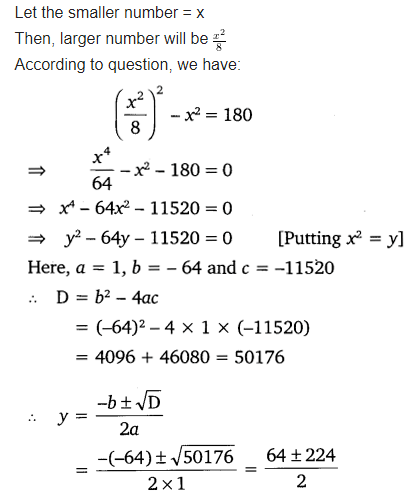

Question 8.
A train travels 360 km at a uniform speed. If the speed had been 5 km/h more, it would have taken 1 hour less for the same journey. Find the speed of the train.
Solution:
Let, the speed of the train be x km/hr.
Time taken to cover 360 km = 360/x hr.
As per the question given,
⇒ (x + 5)(360/x-1) = 360
⇒ 360 – x + 1800/x-5 = 360
⇒ x2 + 5x – 1800 = 0
⇒ x2 + 45x – 40x -1800 = 0
⇒ x(x + 45) -40(x + 45) = 0
⇒ (x + 45)(x – 40) = 0
⇒ x = 40, -45
As we know, the value of speed cannot be negative.
Therefore, the speed of train is 40 km/h.
Question 9. Two water taps together can fill a tank in ![]() hours. The tap of larger diameter takes 10 hours less than the smaller one to fill the tank separately. Find the time in which each tap can separately fill the tank.
hours. The tap of larger diameter takes 10 hours less than the smaller one to fill the tank separately. Find the time in which each tap can separately fill the tank.
Solution:
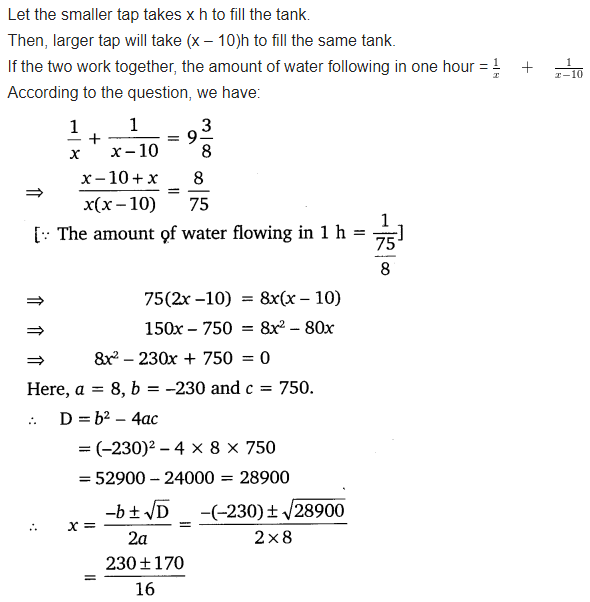
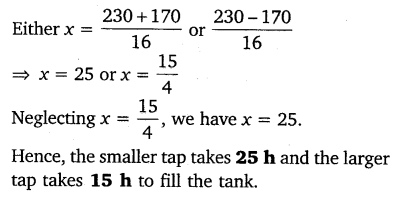
An express train takes 1 hour less than a passenger train to travel 132 km between Mysore and Bengaluru (without taking into consideration the time they stop at intermediate stations). If the average speed of the express train is 11 km/h more than that of the passenger train, find the average speed of the two trains.
Solution:
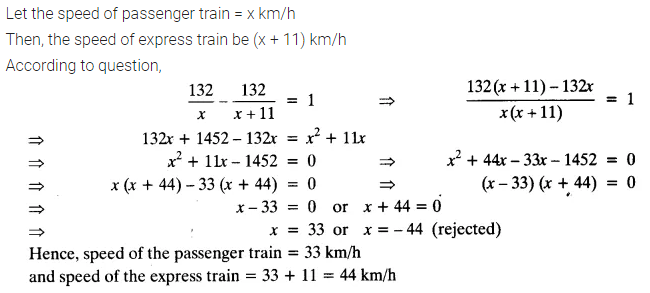
Sum of the areas of two squares is 468 m2. If the difference of their perimeters is 24 m, find the sides of the two squares.
Solution:
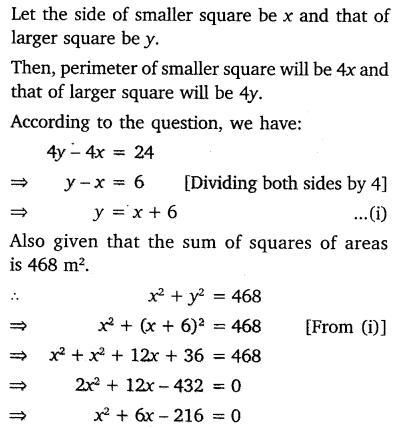
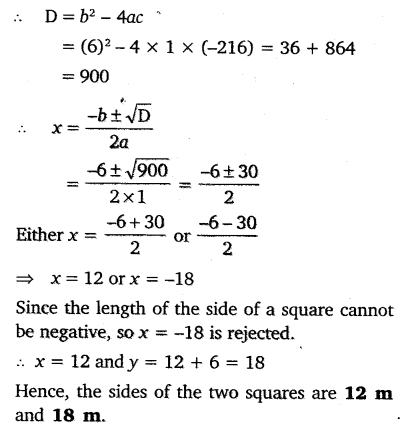
Exercise 4.4
Question 1.
Find the nature of the roots of the following quadratic equations. If the real roots exist, find them:
(i) 2x² -3x + 5 = 0
(ii) 3x2 – 4√3x + 4 = 0
(iii) 2x2-6x + 3 = 0
Solution:
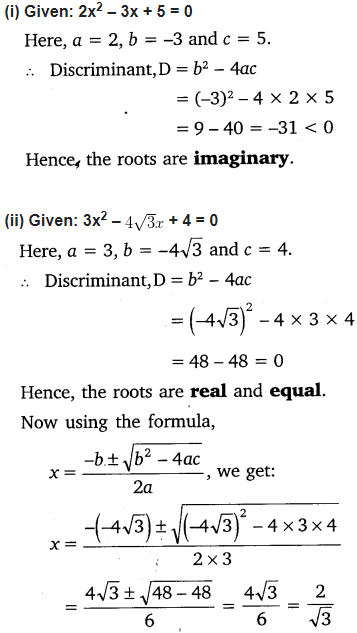
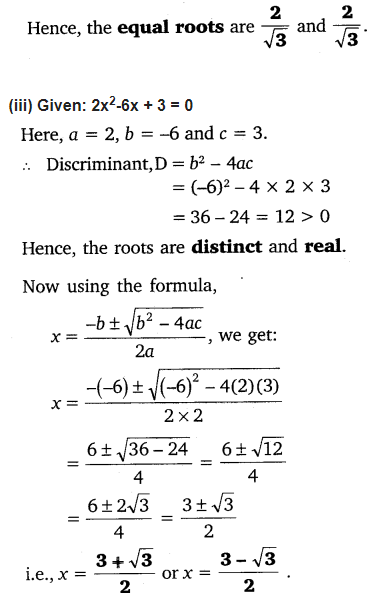
Question 2.
Find the values of k for each of the following quadratic equations, so that they have two equal roots.
(1) 2x2 + kx + 3 = 0
(2) kx (x – 2) + 6 = 0
Solution:
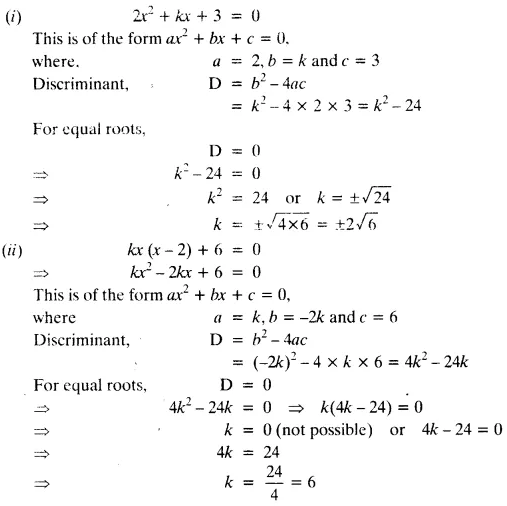
Question 3.
Is it possible to design a rectangular mango grove whose length is twice its breadth, and the area is 800 m2? If so, find its length and breadth.
Solution:
Let the breadth of mango grove be l.
Length of mango grove will be 2l.
Area of mango grove = (2l) (l)= 2l2
2l2 = 800
l2 = 800/2 = 400
l2 – 400 =0
Comparing the given equation with ax2 + bx + c = 0, we get
a = 1, b = 0, c = 400
As we know, Discriminant = b2 – 4ac
=> (0)2 – 4 × (1) × ( – 400) = 1600
Here, b2 – 4ac > 0
Thus, the equation will have real roots. And hence, the desired rectangular mango grove can be designed.
l = ±20
As we know, the value of length cannot be negative.
Therefore, breadth of mango grove = 20 m
Length of mango grove = 2 × 20 = 40 m
Question 4.
Is the following situation possible? If so, determine their present ages.
The sum of the ages of two friends is 20 years. Four years ago, the product of their ages in years was 48.
Solution:
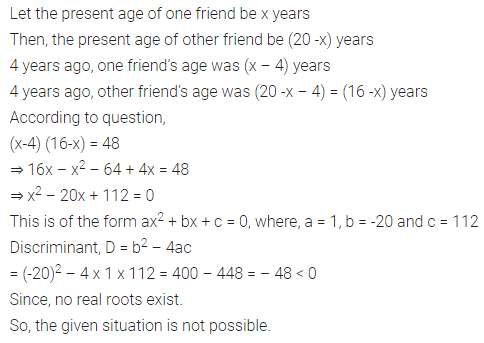
Question 5.
Is it possible to design a rectangular park of perimeter 80 m and area 400 m2? If so, find its length and breadth.
Solution:
